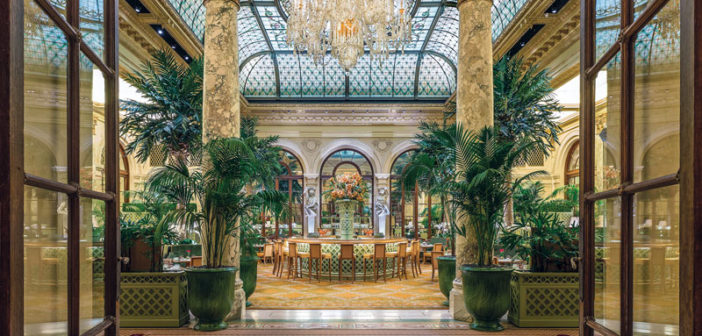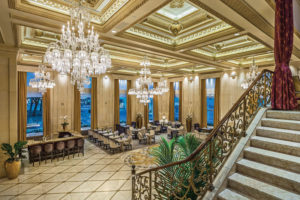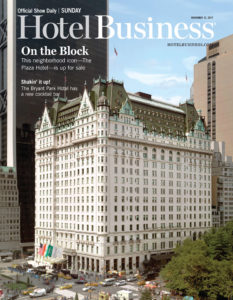NEW YORK—Just as she was celebrating her 110th birthday on Oct. 1, New York’s grande dame hotel, The Plaza, was being courted by any number of suitors looking to pledge their fortunes to have the storied beauty for their own.
Or at least 75% of her.
That’s what’s on the block for those bidding to be the majority owner of The Plaza in this latest chapter currently being written regarding the Fifth Ave. landmark’s chain of ownership.
According to Jeffrey Davis, international director of JLL’s Hotels and Hospitality Group, which is advising Sahara U.S. Corp. on the sale of its stake in the hotel, what’s being offered “includes 75% interest in everything within the real estate of the hotel, including the hotel, the retail and unsold condo-hotel units.”
The Plaza is managed by Fairmont Hotels & Resorts, part of AccorHotels. It has 130 hotel rooms, 152 condo-hotel units, of which 100 are unsold, and approximately 132,000 sq. ft. of retail.
The hotel, which has kept the real estate and hotel industries buzzing over the past several years with potential deals for parts or all of it, was officially on the market this past summer, with the JLL group actively marketing it for about six weeks, taking offers in the third week of October.
“We’ve had quite a bit of interest in the asset,” said Davis.
Managing Director Gilda Perez-Alvarado, who also leads JLL’s Global Hotel Desk, is working with Davis on the sale, with support from JLL VP Brady Rice.
JLL’s Hotels and Hospitality Group has an existing relationship with Sahara; its asset management group handles the asset.
“The Plaza is the most iconic piece of trophy real estate in the world and has long stood as Manhattan’s preeminent luxury hotel,” stated Davis. “This offering gives investors the opportunity to establish an immediate presence with a trophy asset in a high-barrier-to-entry market.” No price is being indicated, he added.
A recent report in The Wall Street Journal noted based on the total number of guestrooms (282), “that would bring a sales price of more than $500 million.”
As far as an assessed value, “It’s too early to tell,” Perez-Alvarado said.
“It is rare to find an opportunity to acquire a truly irreplaceable asset with a tremendous value-add real estate component,” she stated. “The combination of hotel, condo-hotel and retail uses makes this a very interesting investment opportunity for a wide universe of global real-estate investors.”
She added, “The level of interest that we’re getting is commensurate with the real estate itself… It’s one of the most iconic assets in the world. It’s got a tremendous amount of upside. It’s not an easy transaction to do because it’s a 75% interest and there’s a partner… This [sale]is being very well received by the marketplace.”
“The partner” is Saudi prince Al-Waleed bin Talal, who together with CDL Hotels International in 1995 acquired a controlling stake in The Plaza in a deal reportedly valued at $325 million. In 2004, the 805-key hotel sold for $675 million to Israeli-owned developer, Elad Properties (now Elad Group), which renovated the property into guestrooms, condo-hotel rooms, retail and residential units.
According to The New York Times, Elad then turned around and sold a 50% interest in the hotel and a 25% interest in the condo-hotel units to the prince via his Kingdom Holdings.
In 2012, India business group Sahara India Pariwar bought a 75% controlling stake (including hotel/condominium units) from Elad Properties for $570 million. Two years later, Sahara’s Chairman Subrata Roy sought a buyer for the majority stake in the hotel due to facing legal entanglements, including jail time, in India.
This year, reports have Al-Waleed bin Talal partnering with Ashkenazy Acquisition Corp. to buy out Roy. According to a New York Times report citing someone with knowledge of the situation, “Under the ownership agreement, the partners have the right to match any offer for the hotel and to take it over.”
Built in 1907, this iteration of The Plaza (it’s the second one; see our curated timeline) since its inception has stood as a beacon of luxury for a global audience that has “made it,” as well as brought that feeling to guests and locals just happy to make it up The Plaza’s red-carpeted entryway stairs and through its shiny revolving door to be part of its legend, if only for a little while.
Each decade of its existence has brought change to the property across from Central Park, some good, some not, depending on the viewpoint. For example, the 1950s debut of author Kay Thompson’s fictional resident imp, Eloise, is reinforced as a revenue stream more than 60 years later, with a strong retail and marketing program.
And The Plaza’s strong “bones” are still there, thanks to preservation efforts and landmark status. But many observers see the faded use of some of its historic public spaces, like the legendary Oak Room, as a call to action for the next ownership to utilize some of The Plaza’s signature spaces and present their unique attributes to contemporary guests. One example of such change is the prized Palm Court. It recently added a circular bar at its center that melds into the space’s aesthetic. Some industry observers suggested reinstating the PC’s cherished violinists would imbue greater authenticity to the experience.
Asked what type of buyer Sahara might be hoping will acquire its stake, Perez-Alvarado said, “At the end of the day, they just want to sell it to a credible investor. That’s it. It really follows any other normal course of disposition. A certainty of execution and pricing proceeds are the two most important pieces. They’ll sell it to whomever pays the highest price that can perform.”
Break out that piggy bank, Eloise. HB
1883: Construction begins on the first Plaza Hotel, on the former site of the New York Skating Club on Fifth Ave.
1890: The hotel opens on Oct. 1.
1905: The first Plaza Hotel is demolished to build an even larger hotel.
1907: The new Plaza Hotel, constructed in 27 months at a cost of $12.5 million, opens its doors on Oct. 1.
1943: Conrad Hilton and Atlas Corp. acquire the hotel for $7.4 million.
1955: The Childs Co. (later known as Sonesta International Hotels) buys the hotel for $6.2 million.
1969: The NYC Landmarks Preservation Commission grants the hotel landmark status.
1975: Sonesta sells The Plaza to Western International Hotels (later Westin Hotels) for $25 million.
1978: The Plaza is added to The National Register of Historic Places.
1980: The Plaza is added to the New York State Register of Historic Places.
1988: Westin Hotels sells The Plaza to Donald J. Trump for $390 million.
1995: Saudi prince Al-Waleed bin Talal and CDL Hotels International acquire a controlling stake in The Plaza in a deal reportedly valued at $325 million.
2004: The 805-key hotel is sold for $675 million to Israeli-owned developer Elad Properties (now Elad Group).
2005: The Plaza closes its doors for an extensive restoration.
2008: After a $450-million renovation, the hotel reopens with 180 private condominiums, 152 hotel condominiums and 130 hotel rooms. A retail mall becomes part of the lower level.
2012: India’s business group Sahara India Pariwar agrees to buy a 75% controlling stake (including 100 of the hotel/condominium units) from Elad Properties for $570 million.
2014: Sahara’s Chairman Subrata Roy says he’s seeking a buyer for the majority stake in the hotel while facing legal entanglements in India.
2017: Reports have Al-Waleed bin Talal partnering with Ashkenazy Acquisition Corp. to buy out Roy; Sahara puts the property up for sale again, hiring JLL’s Hotels and Hospitality Group to market it. At press time, formal bids were in-house at JLL.





